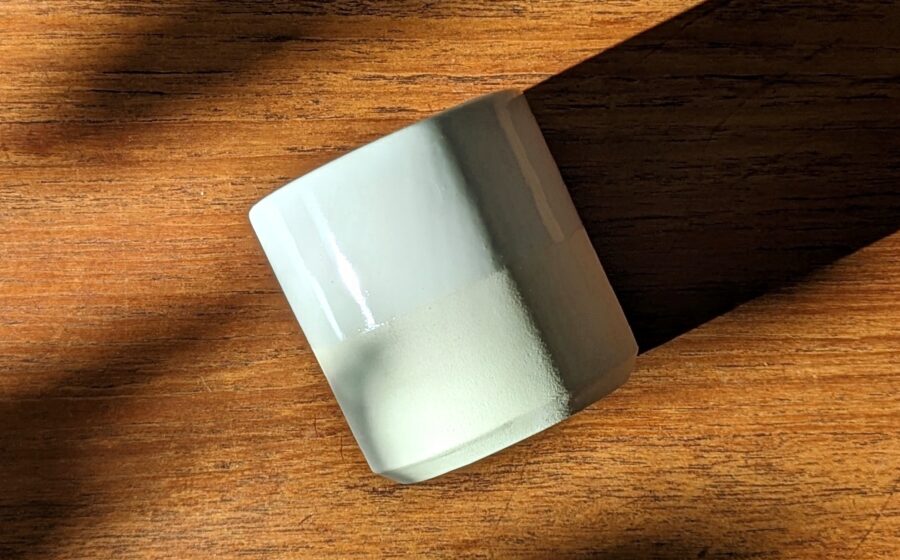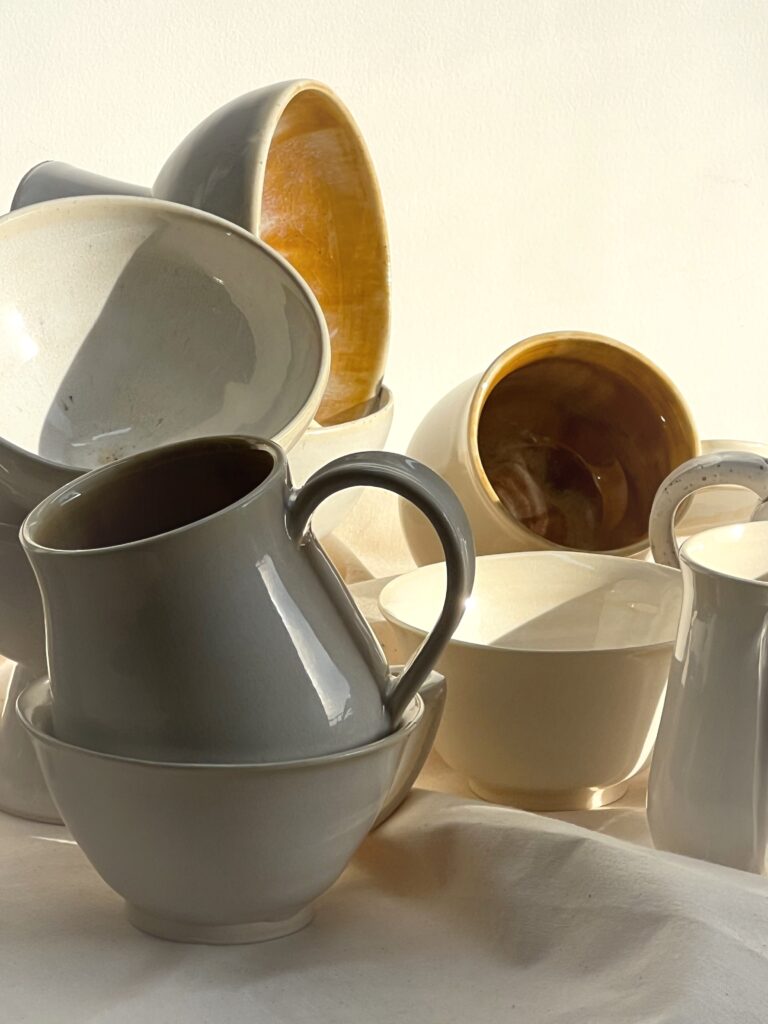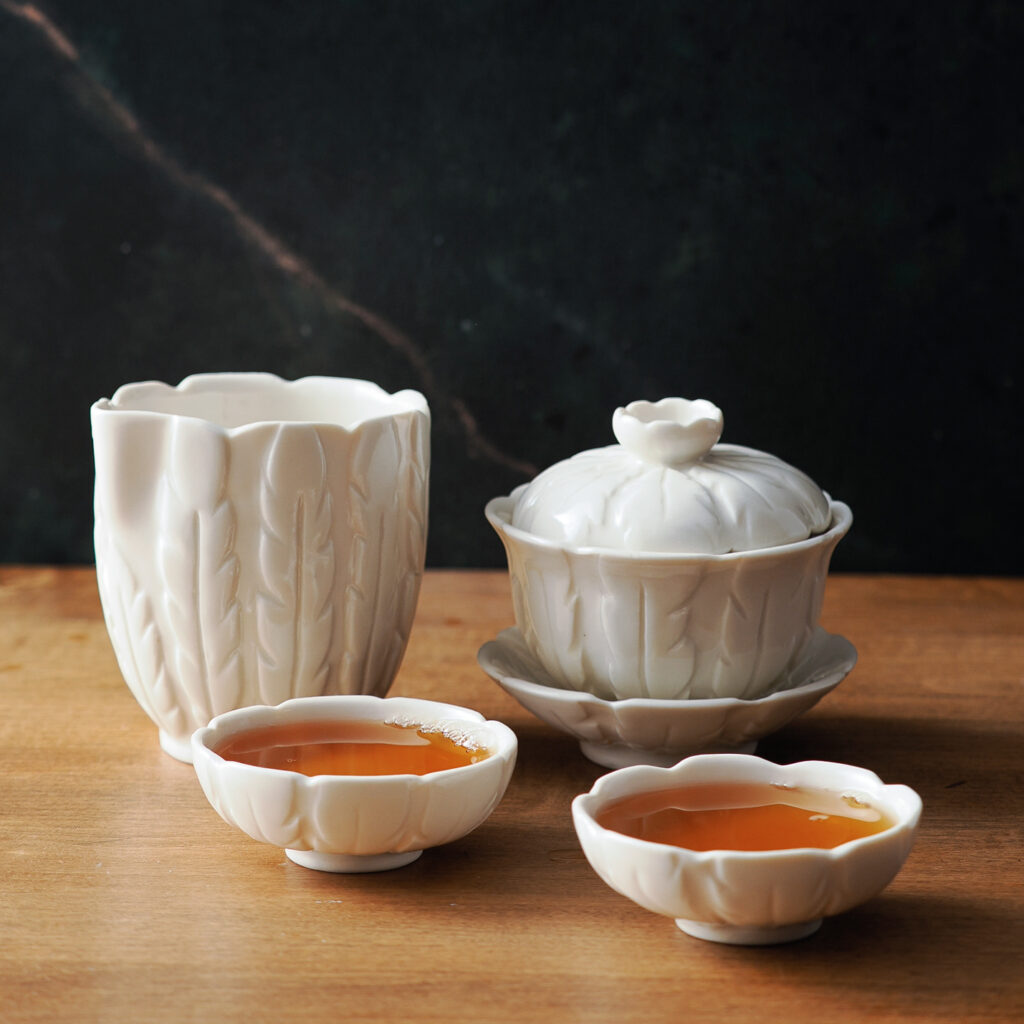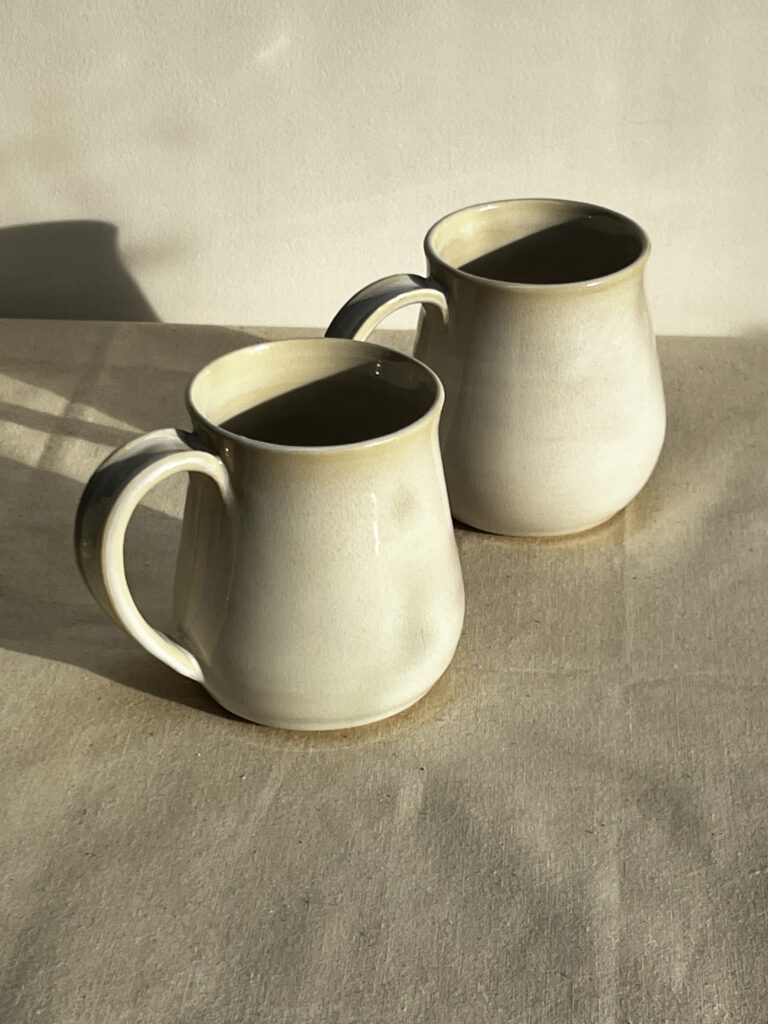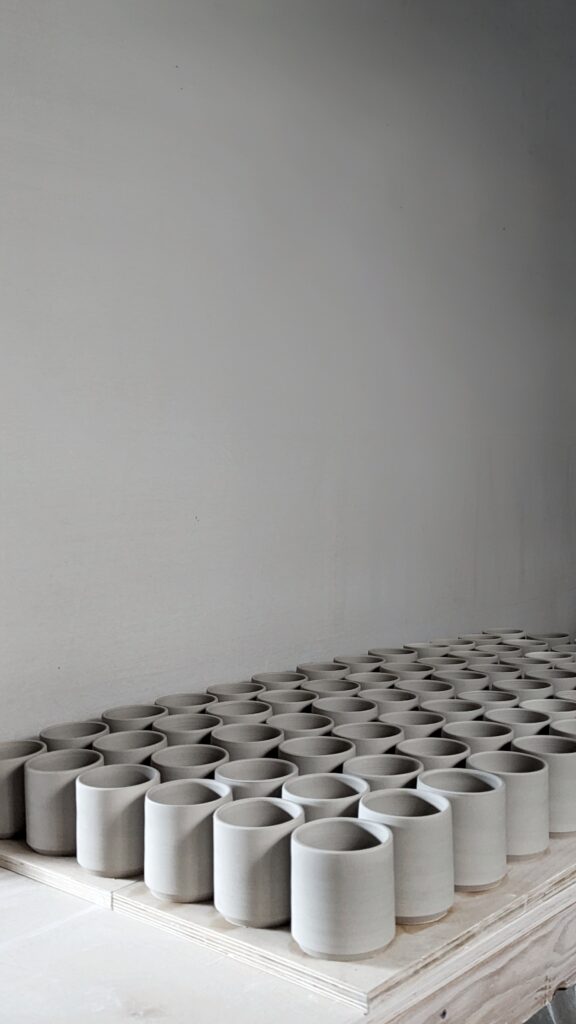A distinguishing feature of third-wave coffee is its markedly precise and technical approach to all things related to sourcing, roasting, brewing, and drinking coffee. This includes, among others, the now-ubiquitous use of scales, thermometers, and timers in coffee brewing and data-plotting software like Cropster and Artisan for roasting.
Unsurprisingly, some cup manufacturers have adopted similarly technical and rigorous standards when designing drinking vessels. Take the iconic LINO collection by notNeutral, a design firm that makes coffee vessels and brewing equipment. The series of coffee wares, including espresso cups, mugs, and saucers, was developed in collaboration with Intelligentsia Coffee baristas and took over eighteen months as notNeutral worked on refining every single detail of the ceramics.
“We wanted them to have larger handles than other commercial cups, so they’d be ergonomic for both the barista and the drinker,” a representative from notNeutral said in an interview in 2015. “We also wanted the espresso cups to be wide enough at the mouth that the drinker could experience the aroma of the coffee. Another goal was to achieve a wall thickness that went from comfortably thin at the lip to thick at the base for heat retention. We also spent considerable time perfecting the angles of the interior walls, and the curvature of the base in order to achieve optimal fluid dynamics for pouring latte art.”
The firm’s approach to LINO’s design typifies the technical and scientific slant that pervades coffee, and some are using cup design to explore how consumers experience and perceive the drink in their hand.
Contemporary Coffee Glasses
Research confirms that cup design affects our drinking experience. Two recent studies, both conducted by Fabiana Carvalho and Charles Spence, demonstrate that both cup shape and color can transform the way we experience drinking coffee—their studies found, for example, that a tulip-shaped cup can enhance the aroma of a coffee. Another study shows a link between round shapes and increased perceived sweetness across different beverages. In contrast, an “angular surface pattern increased perceived bitterness and taste intensity ratings,” the study reports.
Some coffee equipment manufacturers have taken these lessons to heart and developed vessels to highlight different sense qualities or accommodate different coffee origins and roasts. Take Kruve’s EQ glasses: Kruve designed two coffee vessels “scientifically designed to amplify or soften certain flavor notes,” their website reads. Both are double-walled—the Excite “features a bulbous shape and large liquid surface area … [that] traps and circulates aroma, while softening acidity and enhancing sweetness,” while the Inspire “features a narrow inner glass shape and smaller liquid surface area…enhancing acidity.” The Excite is meant for nutty, darker-roasted coffees, while the Inspire is designed to enhance the flavors of floral, lighter-roasted coffees.
Icosa Brewhouse also makes glasses designed to enhance the drinking experience. Their Avensi series offers three vessels: the Vida for all-around drinking, the Senti for medium and darker roasts, and the Alto for lighter roasts.
Icosa is explicit in taking inspiration from the wine and spirits world. “The patent-pending design combines the decades of science and engineering from wine and spirit glasses with what was missing from coffee,” their website reads (emphasis theirs). “Connoisseurs of [wine and spirits] have figured out that the type of glass you serve it in can make or break the entire drinking experience—they consider their glasses the MOST important tool for the fullest appreciation of taste, aroma, and flavor.”
While its apparent cup shape can influence how we experience a beverage, you shouldn’t necessarily rush to the store to buy various drinking vessels. If we look at Icosa’s inspiration point—the wine world—we’ll see that the contemporary view of how glassware affects the drinking experience is much more ambivalent.
A Modern Take On Wine’s Influence
Austrian glassmaker Josef Riedel pioneered the development of grape varietal-specific glass shapes when he introduced the Burgundy Grand Cru glass in 1958. The Grand Cru glass was allegedly designed to better capture the delicate and floral aromas of Pinot Noir coming from this famous region. “The wide tulip shape and slightly flared lip highlights the irresistible sweetness,” Riedel’s website claims, “whilst perfectly balancing the acidity and deemphasizing the alcohol, to create a perfect picture of the wine.”
Since then, Riedel has developed many varietal-specific glasses, including ones that target particular winemaking styles like full-bodied, oaky Chardonnays: “[The] wide open-mouthed bowl enables the rich bouquet to develop its wonderfully diverse range of aromas,” the website reads, “emphasizing the finesse while minimizing the risk of richer style white wines becoming over-concentrated.”
Some research on wineglass types supports the claim that specific shapes can subtly highlight certain varietals better than others. But the improved sensorial experience does not automatically make wine experts go all in on varietal-specific glasses. Famed British Master of Wine and author Jancis Robinson acknowledges the minute benefits different glass shapes bring, but is quoted in a piece by Paul Adams about the history and science of wineglass shapes as saying: “life is just too short to have … lots of slightly different but similar glasses.”
And real-world tests show that perceived differences in wine based on glass shape are minimal at best. In a piece on wine glasses, the New York Times-owned review site Wirecutter recommends universal/all-round glasses instead of varietal-specific ones: “Traditionally, wine glasses have been sold on the premise that you need a smaller bowl for white wines and a larger one for reds,” their findings read. “But our tests proved that a smaller glass doesn’t enhance white wines for most tasters. Similarly, the biggest reds could be as expressive in a medium-size universal glass as in an XL cabernet model. Plus, there are plenty of complex and aromatic white wines that benefit from intense swirling in a larger glass just as much as a chewy red can.”
Longtime New York Times wine critic Eric Asimov is quoted in the piece and expresses outright skepticism of varietal-specific glasses. “I don’t really put stock in the notion that you need different glasses for different types of wine,” he says. “I think that’s an affectation and promoted heavily by self-interested wine glass manufacturers…But it’s also a psychological thing, and if you believe it, then it’s fine.”
Adams’ piece ends with a telling interview with wine chemist Greg Hirson, who has studied the effects of different glass shapes on wine aroma using gas chromatography: “Atmospheric pressure, mood, health, company, lighting, sound, wineglass shape, temperature, focus, and an infinity of other factors will change how the wine is perceived…My initial reason to study this was to see if there was a scientific basis for having the ‘correct’ wineglass. I don’t think there is.”
So even if a glass or cup’s shape influences our tasting, it forms part of a vaster, more holistic experience where other factors play as much of a role in affecting your perception and pleasure.
The Case for Versatility
Should drinkers use and keep different glasses for different coffees—one for nutty Brazils, another for bright Kenyas, one for lighter roasts, yet another for darker ones? Sure, if space and money are of no concern. But, like in wine, there’s room for an all-around coffee cup that can be appealing and practical.
Some coffee drinkers prefer a more ‘neutral’ shape for their drinkware instead of one that accentuates certain qualities. Vancouver-based coffee professional and ceramicist Dustin Ryan Yu is one such coffee drinker.
Yu finds inspiration from the work of researchers looking at the effect of cup design on the tasting experience. Still, for his cups, he opts for “a straight-walled vessel with a slightly elevated foot to look and feel lighter, as a sort of neutral starting point for flavor,” he says in an interview with Scout Magazine. Yu stated in a follow-up interview via email that a neutral shape “allows for a better experience overall. It feels as though I can taste how it was intended to taste, free of at least most biases.”
Yu’s cups were also designed with versatility in mind, being able to blend in or stand out as a ceramic piece. “In many senses, I also think that it is a versatile piece that visually fits with many environments,” Yu writes, “and it sort of blends in with spaces, yet can also stand out on its own as a more luxurious handmade piece.” His designs are adaptable and work as all-around cups for various coffees.
“For me, the perfect coffee cup is versatile, one that you can drink any coffee out of…I like drinking anything that sits on the light- to dark-roasted spectrum of coffees in my own mugs. Maybe it’s the sentimental value, but in a way, it just kind of works for me.” While intentional and still technical, an approach to cup design like Yu’s is not a hard science. His approach is influenced by openly personal preferences.
Allie Caran, a New York-based ceramicist and the former Director of Education for Partners Coffee, also balances technical and aesthetic concerns in their designs. “Lately, I’ve been throwing a lot of large, bell-shaped mugs, similar to Bordeaux glasses.” Caran writes in an email, “This design enhances both aroma and flavor by maximizing surface area.”
When sourcing cafe wares, Caran looked for cups that “provide contextual clues that go beyond utility… I looked for specific things: heat retention, durability, pourability, and overall visual impact.” In particular, she admires the wares from San Francisco-based Heath Ceramics, specifically noting their artistry and look. “Their ceramic lines are timeless and visually stunning.”
A Sense of Touch
Recent studies in both wine and coffee have been incredibly insightful in demonstrating how vessel shapes affect our drinking experience. But, as some in wine argue, the differences in glass shapes can be minimal. The vessels we drink out of matter—but only to an extent, leading many to advocate for universal glasses over varietal-specific ones.
Cup shapes can enhance the smell and tastes we experience from a coffee, but the more closely one breaks down the coffee-drinking experience, a slew of other variables that influence our perception of flavor become apparent. Ultimately, what motivates our hand to reach for a specific cup in the morning extends beyond just smell and taste.
Perhaps your favorite mug holds sentimental value, or you derive pleasure from how a cup’s handle perfectly fits your hands. For Chicago-based potter Danielle Chutinthranond of Monsoon Pottery, it’s about the tactile quality of ‘imperfect’ handmade ceramics. “Imperfections are immortal proof of human connection, and the right customer receives and embraces them,” she writes in an email. “Personally, I can’t stand eating or drinking off of tableware that isn’t handmade anymore…I crave the energetic charge of handmade goods.”
“To me, the point of making something by hand is the human connection, and you either feel that or don’t when you pick up the pot,” Chutinthranond says. To hold a piece in hand, she seeks another hand, mediated through the markings of manually contoured porcelain—”a challenging and rapturous material to work with.”



